
Elba was a protected cruiser of the Italian Regia Marina. She was the fifth of six Regioni-class ships, all of which were named for regions of Italy, with the exception of Elba, which was named for the island. Elba was built by the Regio Cantieri di Castellammare di Stabia shipyard; her keel was laid in September 1890, she was launched in August 1893, and she was commissioned in February 1896. The ship was equipped with a main armament of four 15 cm (5.9 in) and six 12 cm (4.7 in) guns, and she could steam at a speed of nearly 18 knots.
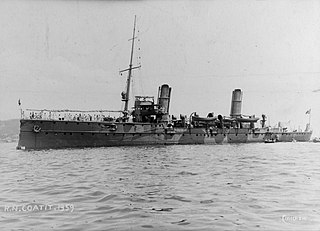
Coatit was a torpedo cruiser of the Italian Regia Marina built in the late 1890s. She was the second and final member of the Agordat class. The ship, which was armed with twelve 76 mm (3 in) guns and two 450 mm (17.7 in) torpedo tubes, was too slow and short-ranged to be able to scout effectively for the fleet, so her career was limited. She saw action during the Italo-Turkish War in 1911–1912, where she provided gunfire support to Italian troops in North Africa. She also caused a minor diplomatic incident from an attack on retreating Ottoman soldiers in Anatolia. Coatit was part of an international fleet sent to Constantinople when the city appeared to be at risk of falling to the Bulgarian Army during the First Balkan War. In 1919, she was converted into a minelayer and was sold for scrap in 1920.

The Agordat class was a pair of torpedo cruisers built by the Italian Regia Marina in the late 1890s. The two ships, Agordat and Coatit, were armed with twelve 76 mm (3 in) guns and two 450 mm (17.7 in) torpedo tubes. They proved to be too slow and have too short a cruising radius to be of much use, so their service careers were limited. Their most significant action came during the Italo-Turkish War of 1911–1912, where both ships were employed in shore bombardment duties. Neither ship saw action in World War I. Coatit was converted into a minelayer in 1919 and sold for scrapping the following year, while Agordat was rearmed as a gunboat in 1921; she followed her sister to the breakers in 1923.

Stromboli was a protected cruiser of the Italian Regia Marina built in the 1880s. She was the second member of the Etna class, which included three sister ships. She was named for the volcanic island of Stromboli, and was armed with a main battery of two 254 mm (10 in) and a secondary battery of six 152 mm (6 in) guns, and could steam at a speed of around 17 knots. Her career was relatively uneventful; the only significant action in which she took part was the campaign against the Boxer Uprising in China in 1900. She returned to Italy in 1901 and spent the rest of her career in reserve or as an ammunition ship, apart from a brief stint in active service in 1904. Stromboli was stricken from the naval register in 1907 and sold for scrapping in 1911.

Euridice was a torpedo cruiser of the Partenope class built for the Italian Regia Marina in the 1880s. She was built by the Regio Cantiere di Castellammare di Stabia shipyard, with her keel laying in February 1889, her launching in September 1890, and her commissioning in May 1891. Her main armament was her six torpedo tubes, which were supported by a battery of ten small-caliber guns. Euridice spent most of her career in the main Italian fleet, where she was primarily occupied with training exercises. She was withdrawn from service in 1907 and sold for scrapping.

Aretusa was a torpedo cruiser of the Partenope class built for the Italian Regia Marina in the 1880s. Laid down in June 1889 at the Cantiere navale fratelli Orlando shipyard, she was launched in March 1891 and was commissioned in September 1892. Her main armament were her six torpedo tubes, which were supported by a battery of ten small-caliber guns. Aretusa spent most of her career in the main Italian fleet, where she was primarily occupied with training exercises. At the start of the Italo-Turkish War in September 1911, she was assigned to the Red Sea Squadron in Italian Eritrea. She bombarded Ottoman positions in the Arabian Peninsula and took part in a blockade of the coast. Worn out by the end of the war in October 1912, Aretusa was sold for scrap that December and broken up.

Caprera was a torpedo cruiser of the Partenope class built for the Italian Regia Marina in the 1880s. She was built by the Cantiere navale fratelli Orlando shipyard; her keel was laid in July 1891, she was launched in May 1894, and was commissioned in December 1895. Her main armament were her five torpedo tubes, which were supported by a battery of eleven small-caliber guns. Caprera spent most of her career in the main Italian fleet, where she was primarily occupied with training exercises. She served in the Red Sea during the Italo-Turkish War of 1911–1912, where she conducted shore bombardments and blockaded Ottoman ports in the area. Caprera did not remain in service long after the war, being sold for scrap in May 1913.
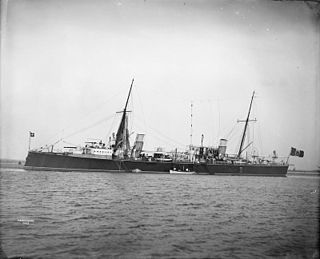
Calatafimi was a torpedo cruiser of the Partenope class built for the Italian Regia Marina in the 1880s. She was built by the Cantiere navale fratelli Orlando shipyard; her keel was laid in July 1891, she was launched in May 1894, and was commissioned in December 1895. Her main armament were her five torpedo tubes, which were supported by a battery of eleven small-caliber guns. Calatafimi spent most of her career in the main Italian fleet, where she was primarily occupied with training exercises. The ship was sold in March 1907 and broken up for scrap.

Saetta was a Folgore-class torpedo cruiser built for the Italian Regia Marina in the 1880s. Armed with three 14 in (356 mm) torpedo tubes and six light guns, she was capable of a top speed of 17 knots. She was built in the mid-1880s, was launched in May 1887, and was completed in February 1888. Saetta spent the first decade of her career serving in the main Italian fleet, where she conducted peacetime training exercises. In 1897, she was withdrawn from front-line service and employed as a gunnery training ship, a role she filled for another decade. The Regia Marina ultimately sold Saetta for scrap in May 1908.

Goito was a torpedo cruiser built for the Italian Regia Marina in the 1880s. She was the lead ship of the Goito class, which included three other vessels. Goito was built by the Regio Cantiere di Castellammare di Stabia shipyard between September 1885 and February 1888. She was armed with a variety of light guns and five 14-inch (356 mm) torpedo tubes, and was capable of a top speed of 18 knots. The ship served the duration of her career in the main Italian fleet. Her early service was primarily occupied with training exercises; front-line duties ended in 1897 when she was converted into a minelayer, though she continued to participate in fleet exercises. During World War I, Goito laid defensive minefields in the Adriatic Sea. She was eventually sold for scrap in 1920 and broken up.

Montebello was the second of four Goito-class torpedo cruisers built for the Italian Regia Marina in the 1880s. She was built at the Arsenale di La Spezia between September 1885 and January 1889, when she entered service. She was armed with a variety of light guns and four 14-inch (356 mm) torpedo tubes, and was capable of a top speed of 18 knots. Montebello spent her active-duty career with the main Italian fleet, where she frequently took part in annual training exercises. In 1903, she was withdrawn from front-line service and converted into a training ship for engine room personnel; she served in this capacity until 1920, when she was sold for scrap.

Monzambano was a torpedo cruiser of the Goito class built for the Italian Regia Marina in the 1880s. The ship was built at the Arsenale di La Spezia, beginning with her keel laying in August 1885 and ending with her completion in August 1889. She was armed with a variety of light guns and five 14-inch (356 mm) torpedo tubes, and was capable of a top speed of 18 knots. The ship spent her career in the main Italian fleet conducting training exercises, and did not see action. She spent 1898 patrolling the eastern Mediterranean Sea with the Levant Squadron. Monzambano was withdrawn from service in 1901 and broken up for scrap that year.
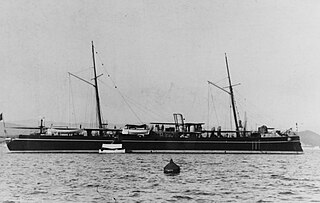
Confienza was the last of four Goito-class torpedo cruisers built for the Italian Regia Marina in the 1880s. She was armed with a variety of light guns and five 14-inch (356 mm) torpedo tubes, and was capable of a top speed of 17 knots. The ship was built in the late 1880s, with her keel laying in September 1887 at the Arsenale di La Spezia; she was completed in April 1890 and thereafter entered service with the Italian fleet. Confienza had a short and uneventful career; she spent her time in Italian waters and did not see any action. Stricken from the naval register in August 1901, she was thereafter broken up for scrap.

The Folgore class was a pair of torpedo cruisers built for the Italian Regia Marina in the 1880s. The two ships—Folgore and Saetta—were designed by Benedetto Brin during a period of experimentation with the theories of the Jeune École in the 1880s. The vessels were armed with three 14 in (356 mm) torpedo tubes, and they had a top speed of 17 knots. Both ships' careers were uneventful, and they spent most of their time in service conducting training exercises. Folgore was seriously damaged in a collision in 1889, and was thereafter reduced to reserve status, as the damage could not be completely repaired. She was eventually sold for scrapping in 1900, while Saetta served as a gunnery training ship from 1897 to 1908, when she too was dismantled.
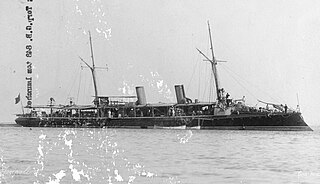
Tripoli was the first modern torpedo cruiser built for the Italian Regia Marina. She was built by the Regio Cantiere di Castellammare di Stabia shipyard in 1885–86. The only vessel of her class, she provided the basis for the Goito and Partenope classes that followed. She was armed with five 14-inch (356 mm) torpedo tubes and a battery of light guns, and was capable of a top speed of 17.5 knots. Tripoli spent her career in the main Italian fleet, where she was occupied primarily with peacetime training exercises. She was modernized several times throughout her career, and in 1910, was converted into a minelayer, a role she served in for another thirteen years, including during World War I. She was the longest serving torpedo cruiser in the Italian fleet, with over 36 years in service by the time she was discarded in March 1923.

Flavio Gioia was a screw corvette of the Italian Regia Marina built in the late 1870s and early 1880s.
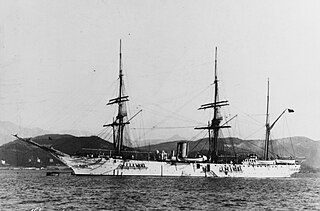
Amerigo Vespucci was a screw corvette of the Italian Regia Marina built in the late 1870s and early 1880s.

Caracciolo was a screw corvette of the Italian Regia Marina built in the 1860s. She was the first vessel of that type built after the unification of Italy, though the Italian fleet inherited several screw corvettes from the navies of Naples, Tuscany, and Sardinia. The ship was armed with a main battery of six 160 mm (6.3 in) guns. Originally built with both steam and sail propulsion, Caracciolo later had her engine removed for use as a training ship.


















